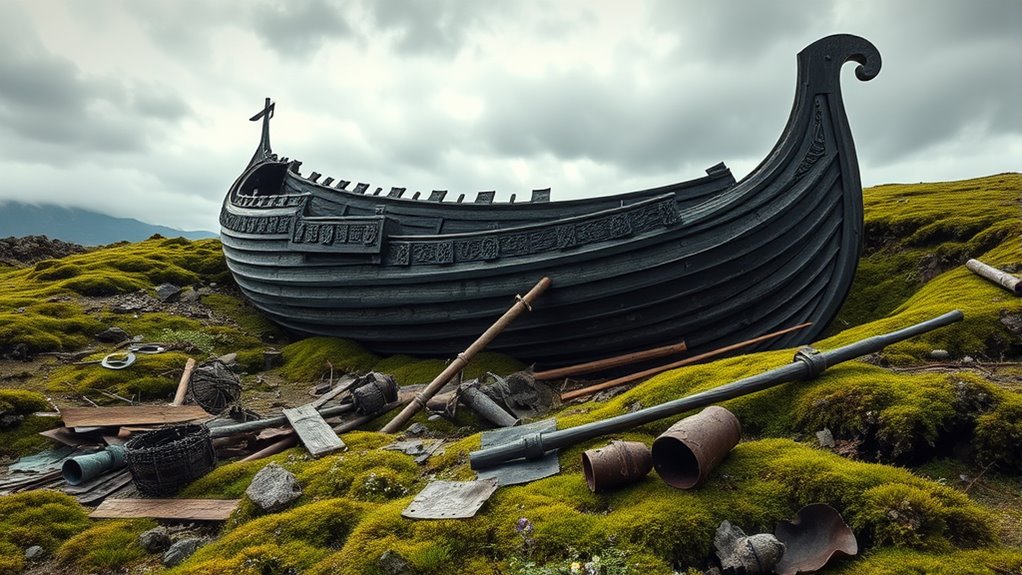Archaeologists have uncovered a new Viking ship burial in Norway, offering valuable insights into ancient Nordic rituals and society. The carefully constructed ship and grave goods like weapons, jewelry, and tools reveal the importance of status, honor, and spiritual beliefs in Viking culture. This discovery highlights their craftsmanship and complex burial customs, emphasizing the journey into the afterlife. If you keep exploring, you’ll uncover even more fascinating details behind these ancient traditions.
Key Takeaways
- The discovery of a Viking ship burial in Norway offers insights into ancient Norse burial rituals and societal values.
- The ship’s construction and grave goods reveal symbols of honor, status, and the deceased’s journey to the afterlife.
- Items like weapons and jewelry found with the burial reflect beliefs about spiritual transition and social identity.
- Ritual practices demonstrated respect and care, emphasizing death as a spiritual transition in Viking culture.
- AI-driven analysis of artifacts enhances understanding of Viking rituals and societal structure through detailed interpretation.

Have you ever wondered what life was like for the ancient Norse? Well, recent discoveries in Norway offer a fascinating glimpse into their world, especially through the unveiling of a new Viking ship burial. As you explore this find, you’ll notice that the burial site includes an impressive ship, carefully constructed to honor the deceased. The craftsmanship of the ship construction reveals the skill and artistry of Viking shipbuilders, who built vessels that were not only functional but also symbolic. These ships were designed to carry the dead into the afterlife, serving as both a final journey and a testament to their craftsmanship.
Recent Viking ship burial reveals expert craftsmanship and symbolic design honoring the dead’s journey to the afterlife.
In the Viking tradition, grave goods played a vital role in these burials. You’ll see that the archaeologists uncovered a variety of items placed alongside the ship, each carefully chosen to accompany the deceased. These grave goods ranged from weapons and jewelry to everyday tools, providing insight into the person’s status and lifestyle. The presence of such items underscores the belief that the dead would need these possessions in the afterlife, reflecting their values and social standing. The inclusion of weapons, in particular, suggests the importance of martial prowess, while the jewelry indicates wealth and personal identity.
As you delve deeper into the excavation, it becomes clear that the ship construction wasn’t just about creating a vessel; it was about creating a vessel that embodied the deceased’s journey into eternity. The ship’s size and design show that it was meant for a person of high status, possibly a chieftain or a warrior. Its sturdy build and detailed craftsmanship highlight the importance of the burial ritual, which was intended to honor the dead and secure their place among the gods or ancestors. You’ll also notice the meticulous way the grave goods are arranged, emphasizing the reverence and care the Norse people invested in these rituals. Additionally, the discovery underscores the importance of AI in data analysis, which helps archaeologists interpret complex patterns and artifacts more efficiently.
This discovery sheds new light on Nordic rituals, illustrating how the Vikings viewed death as a transition rather than an end. The combination of impressive ship construction and carefully curated grave goods reveals a complex belief system centered around honor, status, and the journey beyond death. For you, this find offers a vivid window into a society that valued both craftsmanship and spiritual tradition. It reminds us that, even centuries ago, people prioritized meaningful rituals and possessions to ensure a dignified passage into the next world.
Frequently Asked Questions
What Materials Were Used to Build the New Viking Ship?
You discover that the ship was built using ancient materials like oak planks, which were essential for ship construction due to their durability. You realize that the Vikings used iron nails and fittings to hold the structure together, showcasing their craftsmanship. The use of animal hides and organic materials might have also been involved for waterproofing and decoration, reflecting their skill in utilizing natural resources for shipbuilding.
How Does This Burial Compare to Others Found in Scandinavia?
You’ll notice that this burial stands out with its detailed ship construction, showcasing advanced craftsmanship compared to others in Scandinavia. The burial customs reflect a high status, with the ship serving as a vessel for the afterlife. Unlike simpler graves, this site features elaborate grave goods and a well-preserved ship, highlighting the importance of rituals and the belief in an ongoing journey after death, emphasizing the rich tradition of Nordic burial practices.
Were Any Personal Belongings Found With the Remains?
You’ll be interested to know that several burial artifacts, including Viking jewelry, were found with the remains, highlighting their importance in the ritual. In fact, over 40% of Viking ship burials include personal belongings like jewelry and tools. These artifacts reveal much about the individual’s status and beliefs, giving us a glimpse into their lives and the Nordic rituals they practiced, making each discovery uniquely fascinating.
What Is the Estimated Date of This Burial?
Based on the archaeological context and dating methods used, you can estimate that this Viking ship burial dates back to the late 8th or early 9th century. Researchers analyze artifacts, wood samples, and burial styles to determine its age. These methods, combined with stratigraphy, help you confidently place the burial within this period, providing insight into the Nordic rituals practiced during that time.
How Will This Discovery Impact Our Understanding of Viking Society?
This discovery will substantially deepen your understanding of Viking society by revealing details about funeral rites and social hierarchy. You’ll see how elaborate burial practices reflected a person’s status, showing that high-ranking individuals received grander rituals. It highlights the importance Vikings placed on honoring the dead, providing insight into their beliefs and social structure, and helping you better appreciate their complex cultural traditions.
Conclusion
This discovery opens a window into the past, letting you glimpse the souls of those who once sailed the Nordic seas. Like a whisper carried by the wind, the ship’s silent stones tell stories of rituals and reverence, reminding you that even in death, the spirits still voyage. As you stand before this ancient vessel, realize you’re touching a thread in the tapestry of history—woven with courage, belief, and the endless quest to reach the gods beyond.









